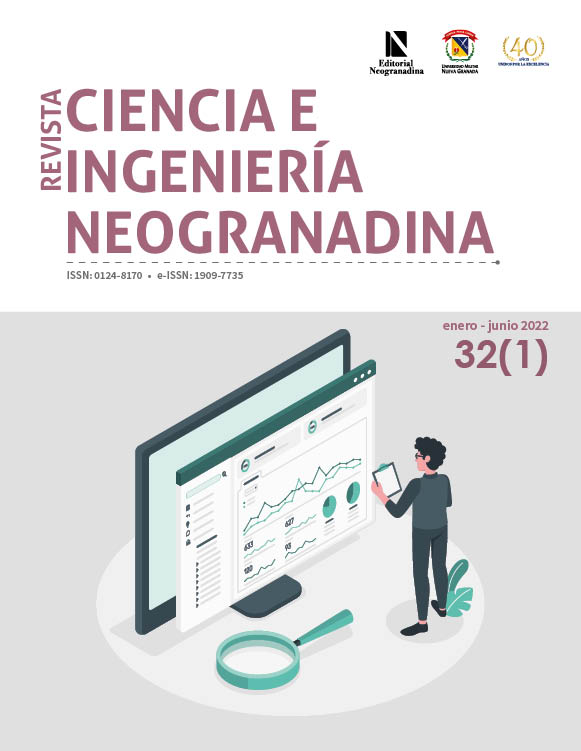Evaluation of an asphalt mixture with the incorporation of recycled concrete aggregates superficially treated with a chemical solution of magnesium sulfate
Abstract
This article analyzed in the laboratory the use of Recycled Concrete Aggregates (RCA) when they are incorporated as coarse aggregates in a hot dense asphalt mixture MDC-19. The main problem of the use of RCA in MDCs is its high absorption caused by the mortar that covers the particles, which causes an increase in the optimum asphalt content and, consequently, high production costs. In order to solve this problem, chemical treatments were carried out on the surface of the RCA aggregate using 1, 3 and 5 cycles of immersion in a magnesium sulfate solution, according to the aggregate durability test specified by AASHTO T 104-99. On the mixtures that incorporated RCA (with and without chemical treatment), resistance tests were carried out under monotonic load (Marshall and indirect tensile strength) and wear resistance to Cantabrian abrasion. The results show that the use of chemically treated RCA in the manufacture of asphalt mixtures increases the resistance un- der monotonic load (Marshall test and indirect tensile strength in dry conditions), providing greater cohesion and a slight increase in adherence with reference to the control mix. Additionally, it was evidenced that the RCA aggregate subjected to 5 cycles provides similar resistance in the asphalt mixture to indirect traction under wet conditions and Cantabrian wear than the control sample.
Downloads
References
M. Arabani y A. R. Azarhoosh, “The effect of recycled concrete aggregate and steel slag on the dynamic properties of asphalt mixtures”, Constr. Build. Mater., vol. 35, pp. 1-7, 2012, doi: https://doi.org/10.1016/j.conbuildmat.2012.02.036
T. Afshar, M. M. Disfani, A. Arulrajah et al., “Impact of particle shape on breakage of recycled construction and demolition aggregates”, Powder Technol., vol. 308, pp. 1-12, 2017, doi: https://doi.org/10.1016/j.powtec.2016.11.043
Eurostat, “Database-eurostat”, Europa.eu. [En línea]. Disponible en: https://ec.europa.eu/eurostat/data/database. [Accedido: 29-nov-2019].
L. Zheng, H. Wu, H. Zhang et al., “Characterizing the generation and flows of construction and demolition waste in China”, Constr. Build. Mater., vol. 136, pp. 405-413, 2017, doi: https://doi.org/10.1016/j.conbuildmat.2017.01.055
Y. F. Silva, R. A. Robayo, P. E. Mattey et al., “Properties of self-compacting concrete on fresh and hardened with residue of masonry and recycled concrete”, Constr. Build. Mater., vol. 124, pp. 639-644, 2016, doi: https://doi.org/10.1016/j.conbuildmat.2016.07.057
J. Chen, Y. Su, H. Si et al., “Managerial areas of construction and demolition waste: a scientometric review”, Int. J. Environ. Res. Public Health, vol. 15, no. 11, p. 2350, 2018, doi: https://doi.org/10.3390/ijerph15112350
G. C. Oliveira-Neto y J. M. F. Correia, “Environmental and economic advantages of adopting reverse logistics for recycling construction and demolition waste: a case study of brazilian construction and recycling companies”, Waste Manag. Res., vol. 37, no. 2, pp. 176-185, 2019, doi: https://doi.org/10.1177/0734242X18816790
A. H. Aljassar, K. B. Al-Fadala y M. A. Ali, “Recycling building demolition waste in hot-mix asphalt concrete: a case study in Kuwait”, J. Mater. Cycles Waste Manag., vol. 7, no. 2, pp. 112-115, 2005, doi: https://doi.org/10.1007/s10163-005-0135-4
S. Paranavithana y A. Mohajerani, “Effects of recycled concrete aggregates on properties of asphalt concrete”, Resour. Conserv. Recycl., vol. 48, no. 1, pp. 1-12, 2006, doi: https://doi.org/10.1016/j.resconrec.2005.12.009
I. Pérez, A. R. Pasandín y J. Gallego, “Stripping in hot mix asphalt produced by aggregates from construction and demolition waste”, Waste Manag. Res., vol. 30, no. 1, pp. 3-11, 2012, doi: https://doi.org/10.1177/0734242X10375747
M. M. Rafi, A. Qadir y S. H. Siddiqui, “Experimental testing of hot mix asphalt mixture made of recycled aggregates”, Waste Manag. Res., vol. 29, no. 12, pp. 1316-1326, 2011, doi: https://doi.org/10.1177/0734242X10370379
A. R. Pasandín y I. Pérez, “Laboratory evaluation of hot-mix asphalt containing construction and demolition waste”, Constr. Build. Mater., vol. 43, pp. 497-505, 2013, doi: https://doi.org/10.1016/j.conbuildmat.2013.02.052
I. Pérez y A. R. Pasandín, “Moisture damage resistance of hot-mix asphalt made with recycled concrete aggregates and crumb rubber”, J. Clean. Prod., vol. 165, pp. 405-414, 2017, doi: https://doi.org/10.1016/j.jclepro.2017.07.140
J. G. Bastidas-Martínez, H. A. Rondón-Quintana y C. A. Zafra-Mejía, “Study of hot mix asphalt containing recycled concrete aggregates that were mechanically treated with a Los Angeles machine”, Int. J. Civ. Eng. Tecnol., vol. 10, no. 10, pp. 226-243, 2019.
D.-H. Shen y J.-C. Du, “Damage-induced modeling of asphalt mixtures through computational micromechanics and cohesive zone fracture,” J. Mater. Civ. Eng. ASCE, vol. 17, no. 5, pp. 477-484, 2005, doi: https://doi.org/10.1061/(ASCE)0899-1561(2005)17:5(477)
A. Ossa, J. L. García y E. Botero, “Use of recycled construction and demolition waste (CDW) aggregates: a sustainable alternative for the pavement construction industry”, J. Clean. Prod., vol. 135, pp. 379-386, 2016, doi: https://doi.org/10.1016/j.jclepro.2016.06.088
S. Bhusal, X. Li y H. Wen, “Evaluation of effects of recycled concrete aggregate on volumetrics of hot-mix asphalt”, Transp. Res. Rec. J. Transp. Res. Board, vol. 2205, no. 1, pp. 36-39, 2011, doi: https://doi.org/10.3141/2205-05
A. Radević, A. Đureković, D. Zakić et al., “Effects of recycled concrete aggregate on stiffness and rutting resistance of asphalt concrete”, Constr. Build. Mater., vol. 136, pp. 386-393, 2017, doi: https://doi.org/10.1016/j.conbuildmat.2017.01.043
A. Akbarnezhad, K. C. G. Ong, M. H. Zhang et al., “Microwave-assisted beneficiation of recycled concrete aggregates”, Constr. Build. Mater., vol. 25, no. 8, pp. 3469-3479, 2011, doi: https://doi.org/10.1016/j.conbuildmat.2011.03.038
H. Shima, H. Tateyashiki, R. Matsuhashi et al., “An advanced concrete recycling technology and its applicability assessment through input-output analysis”, J. Adv. Concr. Technol., vol. 3, no. 1, pp. 53-67, 2005, doi: https://doi.org/10.3151/jact.3.53
A. Arulrajah, J. Piratheepan, M. M. Disfani et al., “Geotechnical and geoenvironmental properties of recycled construction and demolition materials in pavement subbase applications”, J. Mater. Civ. Eng., vol. 25, no. 8, pp. 1077-1088, 2013, doi: https://doi.org/10.1061/(ASCE)MT.1943-5533.0000652
S. Ismail y M. Ramli, “Engineering properties of treated recycled concrete aggregate (rca) for structural applications”, Constr. Build. Mater., vol. 44, pp. 464-476, 2013, doi: https://doi.org/10.1016/j.conbuildmat.2013.03.014
J. P. Giri, M. Panda y U. C. Sahoo, “Performance of bituminous mixes containing treated recycled concrete aggregates and modified by waste polyethylene”, J. Mater. Civ. Eng., vol. 30, no. 8, p. 04018184, 2018, doi: https://doi.org/10.1061/(ASCE)MT.1943-5533.0002384
M. S. Eisa, “Evaluation of hot mix asphalt made with recycled aggregates from demolition waste (radw) coated with bitumen emulsion”, Innov. Infrastruct. Solut., vol. 3, no. 1, p. 17, 2018, doi: https://doi.org/10.1007/s41062-017-0122-3
A. I. Kareem, N. Hamid y H. Asadi, “Performance of hot-mix asphalt produced with double coated recycled concrete aggregates”, Constr. Build. Mater., vol. 205, pp. 425-433, 2019, doi: https://doi.org/10.1016/j.conbuildmat.2019.02.023
A. Kavussi, A. Hassani, F. Kazemian et al., “Laboratory evaluation of treated recycled concrete aggregate in asphalt mixtures”, Int. l f Pavement Res. Technol., pp. 10-16, 2018, doi: https://doi.org/10.1007/s42947-019-0004-5
J. Ma, D. Sun, P. Qi et al., “Potential of recycled concrete aggregate pretreated with waste cooking oil residue for hot mix asphalt”, J. Clean. Prod., vol. 221, pp. 469-479, 2019, doi: https://doi.org/10.1016/j.jclepro.2019.02.256
Instituto Nacional de Vias, “Artículo 450-13: mezclas asfálticas en caliente de gradación continua (concreto asfáltico)”, may 2018.[29] P. Saravanakumar, K. Abhiram y B. Manoj, “Properties of treated recycled aggregates and its influence on concrete strength characteristics”, Constr. Build. Mater., vol. 111, pp. 611-617, 2016, doi: https://doi.org/10.1016/j.conbuildmat.2016.02.064
astm, “Standard test method for resistance to plastic flow of bituminous mixtures using Marshall apparatus. astm D1559-89”, vol. 3, no. Withdrawn, pp. 1-5, 1998, doi: https://doi.org/10.1520/D1559-89
astm Standard D 6931, “Standard test method for indirect tensile (idt) strength of bituminous mixtures”, Www.Astm.Org, vol. i, pp. 1-5, 2017.
Normas de Laboratorio del Transporte España, “NLT-352/00, Caracterización de las mezclas bituminosas abiertas por medio del ensayo cántabro de pérdida por desgaste”, 2000.
I. L. Doyle y J.D. Howard, “Characterization of dense-graded asphalt with the Cantabro test”, J. Test. Eval., vol. 44, no. 1, pp. 77-88, 2016, doi: https://doi.org/10.1520/JTE20140212
B. C. Cox, B. T. Smith, I. L. Howard et al., “State of knowledge for Cantabro testing of dense graded asphalt”, J. Mater. Civ. Eng., vol. 29, no. 10, p. 04017174, 2017, doi: https://doi.org/10.1061/(ASCE)MT.1943-5533.0002020











